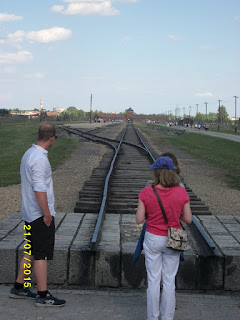I can only assume my knowledge on the concentration camps during WWII is average. I knew the tally was in the millions and the Jewish population was targeted. I knew that IBM devised machines to help track the work and I've seen 'Schindler's List'.
To start we had a 3 hour drive to the site. We stopped halfway for morning tea in a converted aircraft that served awful food but luckily in minuscule portions. I'm sure the garden surrounding the plane was done by someone under the influence of a narcotic.
After lining up for tickets and sorting ourselves out, we started and English speaking tour. The guide had a microphone and we had headphones which stopped any disruption from the other guides' talks. It was a hot day so we brought bottles of water but the clouds were rolling in, so I packed my umbrella as well.
What I didn't know was there were several concentration camps in Auschwitz. The first one used an abandoned Polish Army barracks but they soon realised it didn't have the capacity to hold all the prisoners or to kill enough of them with the gas chambers. Auschwitz II -Birkenau was then made nearby, 20 times larger than the original and could hold at least 60,000 people and kill 7,000 a day. The accommodation blocks were first made by the rubble of the village they cleared to make the camp. They then changed to wooden buildings as it was much quicker to build. The third camp was near the factories to improve efficiency as the prisoners who worked there had a 4 hour return journey back to the original camp.
It seems so clinically efficient. The prisoners leave their belongings at the station that will be collected later and are sent to the showers to be cleaned. After they undress, they are moved into the shower where they are killed by gas. The ovens are right next door and are burnt after the ladies' hair is cut off and the gold teeth are removed.
There are massive warehouses full of belongings. Part of the tour showed us the items they found when the allies finally arrived. Piles of glasses, brushes, pots and pans. One display was the 1,950 kg of the 7 ton found of human hair that was taken from women to make textiles, padding and stiffening for clothes. Out of respect, it was requested that no photos be taken
Babies clothes were on display. Babies. They killed babies. That was probably the hardest part for Dee as a child care worker.
As a person who makes footwear, the 40,000 pairs of shoes that filled 2 display cases probably hit me the hardest. From kids shoes, to work boots to fancy ladies' footwear.
How the chosen 20% lived for the expected 3 months they were there until they died of starvation, their punishments and their daily routine was almost numbing.
Visiting the gas chamber and ovens was almost surreal.
After a 15 minute break, we completed the 2nd part of the tour to the Auschwitz-Birkenau camp. The temperature was rising, we had hats, drinking water and even using the umbrella but it was hot. So much of the camp was destroyed by the Nazis but the chimney stacks of the wooden huts still stand.
We saw reconstructed wooden huts for living and sanitation. We stood on the ground between the two train tracks where the sorting occurred. We walked down the path to the gas chambers where so many people walked down once.
Before that day, I've seen the results of when people stop thinking of others are people. After the tour, my personal thoughts on humanity and the lack of it were reinforced. When people say, 'They aren't like us' I can see what those words may eventually lead to.
They estimate that 1.3 million men women and children died over the 4 years of Auschwitz. That's like killing the population of Canberra every year for 4 years. I can't imagine it but it happened. I'll do my hardest to not let it happen again and stopping it where it does today.











No comments:
Post a Comment